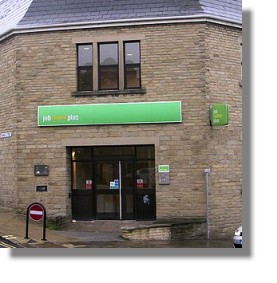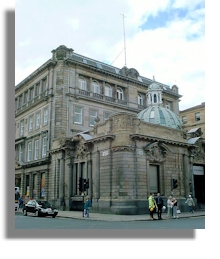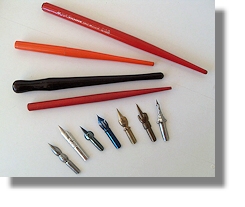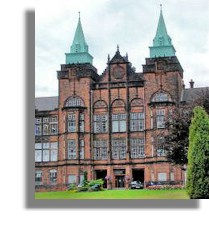Scottish Memory Lane - First Full-time Employment

Job Centre Plus © Betty Longbottom via Wikimedia Commons
After years of education at school - or further education or university, our first big step into adulthood is starting our first full-time paid employment. Regular hours, new experiences and skills, responsibilities, colleagues, being assessed on how well you are performing and wondering what the future will hold. And of course earning some money, perhaps for the first time!
From Ledger Book to Laser Beam

After completing full time education at secondary school, I decided for various reasons not to go to university like many of my school friends but to start earning money. And so it was that I applied and was accepted as a trainee bank clerk at the Savings Bank of Glasgow head office at 177 Ingram Street (seen here). It was an odd choice for someone who had managed a unique (?) combination of Higher level Mathematics but managed to fail arithmetic in the final year exams! This was the late 1950s and although there were a few mechanical adding machines around, most of the long columns of figures were summed manually. I actually became quite adept at this and to this day prefer adding up lists of numbers by hand.
The first trustee savings bank was established by Reverend Henry Duncan of Ruthwell in Dumfriesshire for his poorest parishioners in 1810 with its sole purpose being to serve the local people in the community at a time when the commercial banks minimum deposit was equivalent to the annual wages of most working people. The concept grew rapidly in Scotland and the UK and eventually around the world. The Glasgow bank in the late 1950s was the largest savings bank in the UK with around 70 branches.
Of course at that time, all the bank records were hand-written, using pens with steel nibs and ink. As the office junior my first task in the morning was to ensure that the ink wells on the customer side of the counters had a good supply of ink and that the steel nibs were in good condition and not rusty - and that the blotting paper was clean and tidy. It took a lot of Google searches to track down a picture of the type of pens and nibs we used in those days (quill pens would have been easier to track down!) and this one is © Fernando Martello via Wikimedia Commons. I recall that most of us pushed pens like these behind our ears so that they were near at hand when we needed to write (which was often!)
Initially, my job was to take the handwritten bank passbooks from a clerk at the front counter who recorded the latest deposit or withdrawal being made by the customer and updating the ledger cards with the transaction and, using printed tables, calculating the effect of the transaction on a running total of interest due. It was a very repetitive task with hundreds of transactions each day. I vividly recall at the end of the first week asking myself "will I have to do this for the next 20 years before I become a manager?" Fortunately, once I had moved from the Head Office to a branch, the job became much more interesting, particularly dealing with the large variety of customers quite apart from the wide range banking tasks which I had to learn.
The picture here is of the bank cashiers (tellers) on the front counter in the 1920s. By the 1950s there were fewer staff and after World War II there were also lady cashiers. They were paid less than the men, in part because all male staff were expected to study for professional banking qualifications. Girls recruited to the bank even in the 1950s and 1960s were positively discouraged from taking the exams - no senior executives (all men) in those days would have dreamt of having a female branch manager!
About ten years after joining the bank I became involved in the computerisation of all the bank's account records and so was at least partly responsible for all the ledger cards, steel nibs and blotting paper being swept away and - eventually - cashiers connected via counter terminals direct to the mainframe computer system where transactions were updated within a fraction of a second. By 1988, all the Savings Banks in the UK were on one computer system. As a by-product of my involvement in computerisation, in my spare time I began a Web site called "Rampant Scotland Directory" - but that's a story for another day!
The history of savings banks in Scotland from 1810 to 1990 was later published and it had the title:
Scottie, Glasgow.
Employment Delayed Five Years After School.

The first summer after my 6th year in secondary school, (6th because I had been told that I was too young to start at Jordanhill training to be a teacher, although I had already been accepted after gaining my 'Highers' the year before), I set off 3 days before the end of term with two other students and a teacher, to travel to Loch Rannoch. (Graphic © Richard Webb via Wikimedia Commons)
We were the 'Advance Party' for the forestry camp that year, the third one I had attended. We drove in a small Ford all the way to a former commando training camp about the middle of the south shore of the loch. Our job was to tidy up the two billets, cookhouse and dining room that had last been 'home' to a Canadian group. Our first horror discovery was a handful of live rifle bullets in each of the stoves in the billets, and later, a crate of hand grenades on the shore of the loch!! The purpose of our work was to clear all the forestry 'scrap' of branches, twigs and what have you, place them in large piles in safe places, and burn them.
My most comical memory of the five weeks or so we spent there was one day when three of us had built a large pile, about 8 feet high and 12 in diameter on a bench about 50 feet up the hillside from the road. Suddenly, it began to rain very heavily, and since we were about 2 miles from the camp, we very quickly pulled a lot of branches out of the middle of the pile to form a small cave that we were able to get into out of the rain. As we crouched in our wee shelter, the forestry keeper came strolling by, and, with a smile on his face, and a typical Highland lilt to his voice, said "aye, it's a wee bit o' a Scots mist"! This as the rain was bouncing up about 8 inches off the rocks!!. This was only one of a number of examples of Highlander understatement that I came across, and led me to appreciate their attitude to life. Graphic © Dr Richard Murray via Wikimedia Commons.
The next 3 years of my life was spent at Jordanhill College (pictured here), learning to be a teacher of technical subjects, and discovering that this was what I was really meant to be, because I loved teaching. Before I left college, I was assured that I would have a post in Renfrewshire, by the Director of Technical subjects for the county, and was later informed that I was to report to St. Mirins' Academy that was located in Paisley on the Renfrew Road.
This was in 1949. The 'Cold War' had started, and about 2 weeks before I was due to start, I received notice that I was to report to R.A.F Padgate near Warrington in Lancashire on September 11th. (Graphic is of River Mersey at Padgate, © David Long via Wikimedia Commons). I think I was in the second batch of national servicemen at that time, but I was still dismayed at the thought of not starting my career. I actually did teach for a week, and got paid for it, before I had to catch the train from Central station in Glasgow, on the morning of September 11th, my brother's' birthday! I had to change trains at Preston to a local line to take me to Warrington, where I was picked up and taken to R.A.F Padgate, which was very close.
There began the process of entering the Royal Air Force, measured for uniforms, and lining up for "short back and side" haircuts and inoculations. (Graphic of RAF uniform via Wikimedia Commons) When the lad behind me stepped forward to get his shot, he fainted as the needle went into his arm. The chap behind him made some remark about what was he going to do if the training was a lot harder than this. I smiled, and introduced myself to him, and he told me his name was Victor Pascoe, and this became the beginning of a long lasting friendship, because we spent the rest of our service together, even when our 18 months of service was changed to 2 years when the Korean war broke out when we were half way through our original service.
When we were finally transferred to No. 2 Radio School, R.A.F. Yatesbury in Wiltshire (Graphic of Royal Flying Corps Badge from Yatesbury Church © Brian Robert Marshall via Wikimedia Commons) We were both trained as Air Wireless Mechanics, and then selected to be instructors on the course and given the rank of corporal, he very often took me on long weekend leaves to his home in Ramsgate on the north east coast of Kent. This part of Kent was known in ancient times as the Isle of Thanet. I spent many happy hours there, and Vic. was my best R.A.F. buddy. When we were 'demobbed' on September 11th. !951, we kept in touch even when I came to Canada with my family.
David Picken, now in Calgary, Alberta
Return to Index of Memory Lane.






